Creating an online store with 1C-Bitrix: Site Management using Terraform
To create an infrastructure for an online store with 1C-Bitrix: Site Management using Terraform:
If you no longer need the resources you created, delete them.
Prepare your cloud
Sign up for Yandex Cloud and create a billing account:
- Navigate to the management console
- On the Yandex Cloud Billing
ACTIVEorTRIAL_ACTIVEstatus. If you do not have a billing account, create one and link a cloud to it.
If you have an active billing account, you can navigate to the cloud page
Learn more about clouds and folders here.
Required paid resources
- VM instance: use of computing resources, storage, public IP address, and OS (see Compute Cloud pricing).
- Managed Service for MySQL® cluster: computing resources allocated to hosts, size of storage and backups (see Managed Service for MySQL® pricing).
- Public IP addresses if public access is enabled for cluster hosts (see Virtual Private Cloud pricing).
This tutorial uses the trial version of 1C-Bitrix with a 30-day trial period. You can check the cost of the product software versions on the 1C-Bitrix
Create an infrastructure
With Terraform
Terraform is distributed under the Business Source License
For more information about the provider resources, see the relevant documentation on the Terraform
To create an infrastructure using Terraform:
-
Install Terraform, get the authentication credentials, and specify the source for installing the Yandex Cloud provider (see Configure your provider, step 1).
-
Prepare files with the infrastructure description:
Ready-made configurationManually-
Clone the repository with configuration files.
git clone https://github.com/yandex-cloud-examples/yc-bitrix-website.git -
Navigate to the repository directory. Make sure it contains the following files:
bitrix-website.tf: Your infrastructure configuration.bitrix-website.auto.tfvars: User data file.
- Create a directory for configuration files.
- In the directory, create:
-
bitrix-website.tfconfiguration file:bitrix-website.tf
# Declaring variables for confidential parameters variable "folder_id" { type = string } variable "vm_user" { type = string } variable "ssh_key_path" { type = string } variable "mysql_user" { type = string } variable "mysql_password" { type = string sensitive = true } # Configuring a provider terraform { required_providers { yandex = { source = "yandex-cloud/yandex" version = ">= 0.47.0" } } } provider "yandex" { zone = var.folder_id } # Creating a cloud network and subnets resource "yandex_vpc_network" "network-1" { name = "network1" } resource "yandex_vpc_subnet" "subnet-1" { name = "subnet1" zone = "ru-central1-a" network_id = yandex_vpc_network.network-1.id v4_cidr_blocks = ["192.168.1.0/24"] } resource "yandex_vpc_subnet" "subnet-2" { name = "subnet2" zone = "ru-central1-b" network_id = yandex_vpc_network.network-1.id v4_cidr_blocks = ["192.168.2.0/24"] } resource "yandex_vpc_subnet" "subnet-3" { name = "subnet3" zone = "ru-central1-d" network_id = yandex_vpc_network.network-1.id v4_cidr_blocks = ["192.168.3.0/24"] } # Create security groups resource "yandex_vpc_security_group" "sg-vm" { name = "bitrix-sg-vm" description = "Description for security group" network_id = yandex_vpc_network.network-1.id egress { protocol = "ANY" description = "ANY" v4_cidr_blocks = ["0.0.0.0/0"] from_port = 0 to_port = 65535 } ingress { protocol = "TCP" description = "EXT-HTTP" v4_cidr_blocks = ["0.0.0.0/0"] port = 80 } ingress { protocol = "TCP" description = "EXT-SSH" v4_cidr_blocks = ["0.0.0.0/0"] port = 22 } ingress { protocol = "TCP" description = "EXT-HTTPS" v4_cidr_blocks = ["0.0.0.0/0"] port = 443 } } resource "yandex_vpc_security_group" "sg-mysql" { name = "bitrix-sg" description = "Security group for mysql" network_id = yandex_vpc_network.network-1.id egress { protocol = "ANY" description = "any" v4_cidr_blocks = ["0.0.0.0/0"] from_port = 0 to_port = 65535 } ingress { protocol = "TCP" description = "ext-msql" v4_cidr_blocks = ["0.0.0.0/0"] port = 3306 } } # Adding a prebuilt VM image data "yandex_compute_image" "ubuntu-image" { family = "ubuntu-2204-lts" } # Creating a boot disk resource "yandex_compute_disk" "boot-disk" { name = "bootdisk" type = "network-ssd" zone = "ru-central1-a" size = "24" image_id = data.yandex_compute_image.ubuntu-image.id } # Creating a VM instance resource "yandex_compute_instance" "vm-bitrix" { name = "bitrixwebsite" platform_id = "standard-v3" zone = "ru-central1-a" resources { core_fraction = 20 cores = 2 memory = 4 } boot_disk { disk_id = yandex_compute_disk.boot-disk.id } network_interface { subnet_id = yandex_vpc_subnet.subnet-1.id security_group_ids = ["${yandex_vpc_security_group.sg-vm.id}"] nat = true } metadata = { user-data = "#cloud-config\nusers:\n - name: ${var.vm_user}\n groups: sudo\n shell: /bin/bash\n sudo: 'ALL=(ALL) NOPASSWD:ALL'\n ssh_authorized_keys:\n - ${file("${var.ssh_key_path}")}" } } # Creating a Managed Service for MySQL cluster resource "yandex_mdb_mysql_cluster" "bitrix-cluster" { name = "BitrixMySQL" environment = "PRESTABLE" network_id = yandex_vpc_network.network-1.id version = "8.0" security_group_ids = ["${yandex_vpc_security_group.sg-mysql.id}"] resources { resource_preset_id = "s2.micro" disk_type_id = "network-hdd" disk_size = "10" } host { zone = "ru-central1-a" subnet_id = yandex_vpc_subnet.subnet-1.id assign_public_ip = false } host { zone = "ru-central1-b" subnet_id = yandex_vpc_subnet.subnet-2.id assign_public_ip = false } } # Creating a MySQL database resource "yandex_mdb_mysql_database" "bitrix-db" { cluster_id = yandex_mdb_mysql_cluster.bitrix-cluster.id name = "db1" } # Creating a database user resource "yandex_mdb_mysql_user" "bitrix-user" { cluster_id = yandex_mdb_mysql_cluster.bitrix-cluster.id name = var.mysql_user password = var.mysql_password permission { database_name = yandex_mdb_mysql_database.bitrix-db.name roles = ["ALL"] } } -
bitrix-website.auto.tfvarsuser data file:bitrix-website.auto.tfvars
folder_id = "<folder_ID>" vm_user = "<VM_username>" ssh_key_path = "<path_to_file_with_public_SSH_key>" mysql_user = "<DB_username>" mysql_password = "<DB_user_password>"
-
For more information about the properties of Terraform resources, see the provider documentation:
- Network: yandex_vpc_network.
- Subnets: yandex_vpc_subnet.
- Security groups: yandex_vpc_security_group.
- Image: yandex_compute_image.
- Disk: yandex_compute_disk.
- VM instance: yandex_compute_instance.
- [MySQL cluster: yandex_mdb_mysql_cluster.
- Database: yandex_mdb_mysql_database.
- DB user: yandex_mdb_mysql_user.
-
-
In the
bitrix-website.auto.tfvarsfile, set the following user-defined properties:folder_id: Folder ID.vm_user: VM username.ssh_key_path: Path to the file with a public SSH key to authenticate the user on the VM. For more information, see Creating an SSH key pair.mysql_user: Username for connecting to the MySQL® DB. To complete this tutorial, specifyuser1.mysql_password: User password to access the MySQL® DB. To complete this tutorial, specifyp@s$woRd!.
-
Create the resources:
-
In the terminal, go to the directory where you edited the configuration file.
-
Make sure the configuration file is correct using this command:
terraform validateIf the configuration is correct, you will get this message:
Success! The configuration is valid. -
Run this command:
terraform planYou will see a detailed list of resources. No changes will be made at this step. If the configuration contains any errors, Terraform will show them.
-
Apply the changes:
terraform apply -
Type
yesand press Enter to confirm the changes.
-
Configure your VM for 1C-Bitrix
To configure a server for 1C-Bitrix:
-
Connect to the VM over SSH on behalf of the user specified when creating the VM, e.g.,
ubuntu:ssh ubuntu@<VM_public_IP_address>You can look up the VM's public IP address in the management console
-
Install the required software:
Note
The below install commands are for Ubuntu. For other distributions, use the relevant commands of your packet manager.
sudo apt-get update sudo apt-get install -y apache2 libapache2-mod-php php-gd php-mbstring php-mysql -
Go to the project's working folder and download the 1C-Bitrix: Site Management distribution:
cd /var/www/html/ sudo wget https://www.1c-bitrix.ru/download/business_encode.tar.gz -
Unpack the downloaded archive and delete unnecessary files:
sudo tar -zxf business_encode.tar.gz sudo rm -f index.html business_encode.tar.gz -
Make the
www-datauser the owner of the project's working folder:sudo chown -R www-data:www-data /var/www/htmlCheck the permissions and owners of the working folder:
ls -lResult:
total 40 drwxrwxr-x 7 www-data www-data 4096 Jun 8 2023 bitrix -rwxrwxr-x 1 www-data www-data 1150 Nov 30 2020 favicon.ico -rwxrwxr-x 1 www-data www-data 1353 Jun 8 2023 index.php -rwxrwxr-x 1 www-data www-data 268 Apr 17 2023 install.config -rwxrwxr-x 1 www-data www-data 12821 Mar 18 2022 readme.html -rwxrwxr-x 1 www-data www-data 112 Mar 27 2013 readme.php drwxrwxr-x 2 www-data www-data 4096 Jun 8 2023 upload -
For 1C to work correctly, configure the PHP settings. To do this, use the built-in
nanoeditor and modify the following variables in thephp.iniconfiguration file:sudo nano /etc/php/8.1/apache2/php.iniPreviously Now short_open_tag = Offshort_open_tag = Onmemory_limit = 128Mmemory_limit = 256M;date.timezone =date.timezone = Europe/Moscow;opcache.revalidate_freq =2opcache.revalidate_freq =0;session.save_path = "/var/lib/php/sessions"session.save_path = "/var/lib/php/sessions"The
php.inifile path depends on the PHP version installed. The example shows the path for version8.1. For8.0, enter/etc/php/8.0/apache2/php.ini; for8.2,/etc/php/8.2/apache2/php.ini, etc.Tip
To find the parameter you need in the
nanoeditor, press Ctrl + W. Find the required parameter from the table above and save the changes using Ctrl + O. To exit the editor, press Ctrl + X. -
Configure the Apache web server. To do this, edit the
/etc/apache2/sites-enabled/000-default.confconfiguration file.-
Open the file in the text editor:
sudo nano /etc/apache2/sites-enabled/000-default.conf -
After the
DocumentRoot /var/www/htmlline, add the following section and save the changes:<Directory /var/www/html> Options Indexes FollowSymLinks AllowOverride All Require all granted </Directory> -
Restart the web server to apply all the updated settings:
sudo systemctl restart apache2
-
After you run these commands, the server side will be configured for 1C-Bitrix to work correctly.
Configure 1C-Bitrix
Install and configure 1C-Bitrix:
-
Open the 1C-Bitrix: Site Management web interface at
http://<VM_public_IP_address>/in your browser. A page will open prompting you to install 1C-Bitrix. -
Click Next on the installer welcome screen.
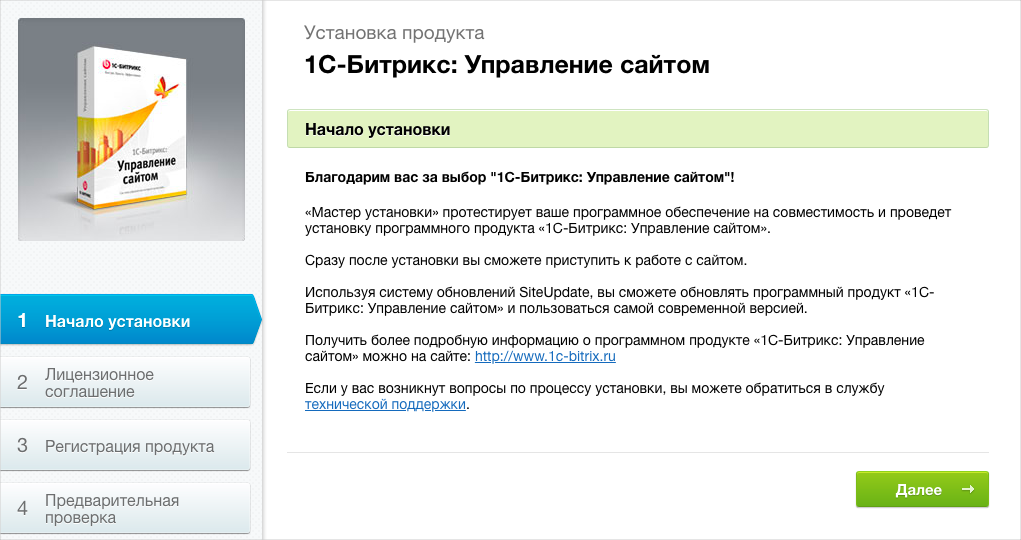
-
Read the license agreement and select I accept the license agreement. Then click Next.
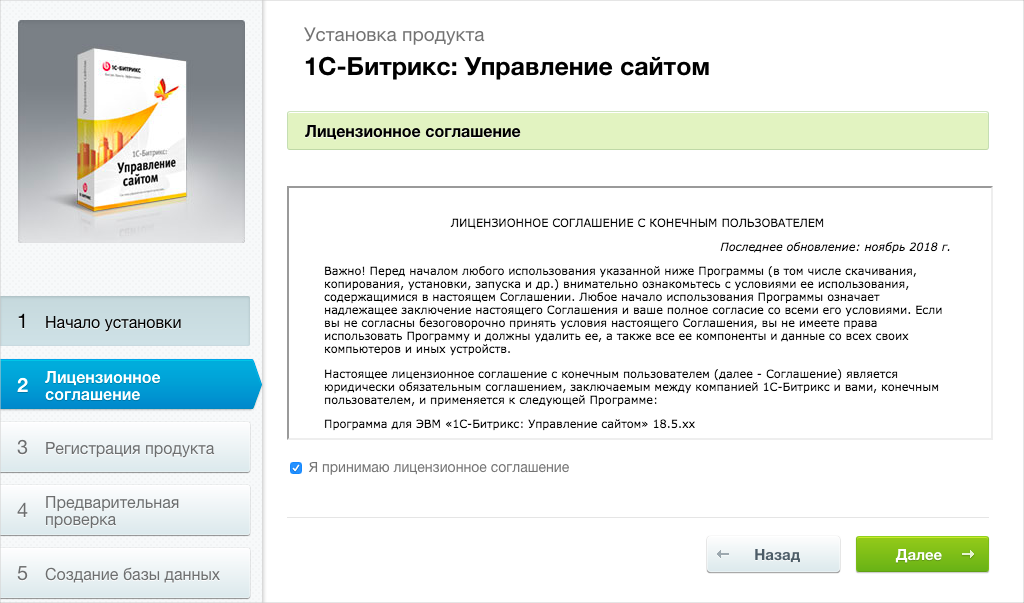
-
You do not need to register the product (you can disable this option). Make sure the Install in UTF-8 encoding option is selected and click Next.
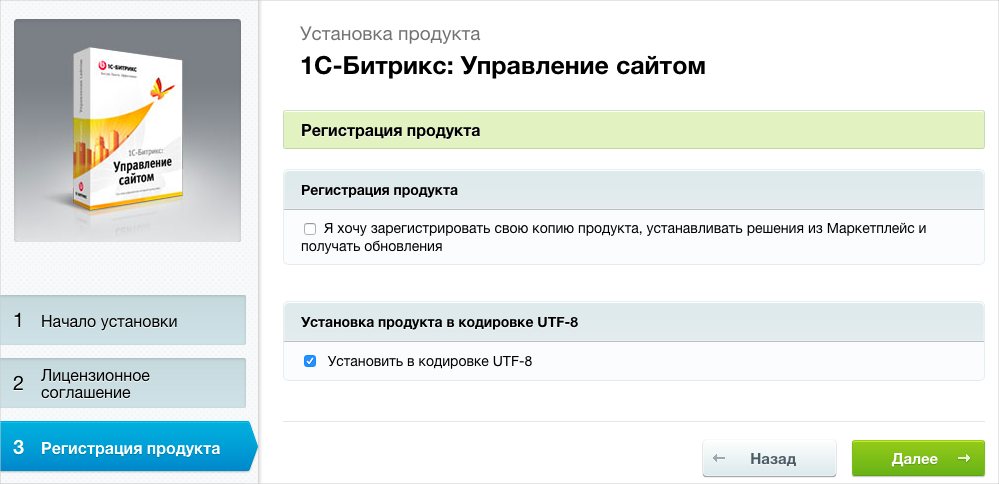
-
1C-Bitrix will check if the server is configured correctly. Click Next at the bottom of the page.
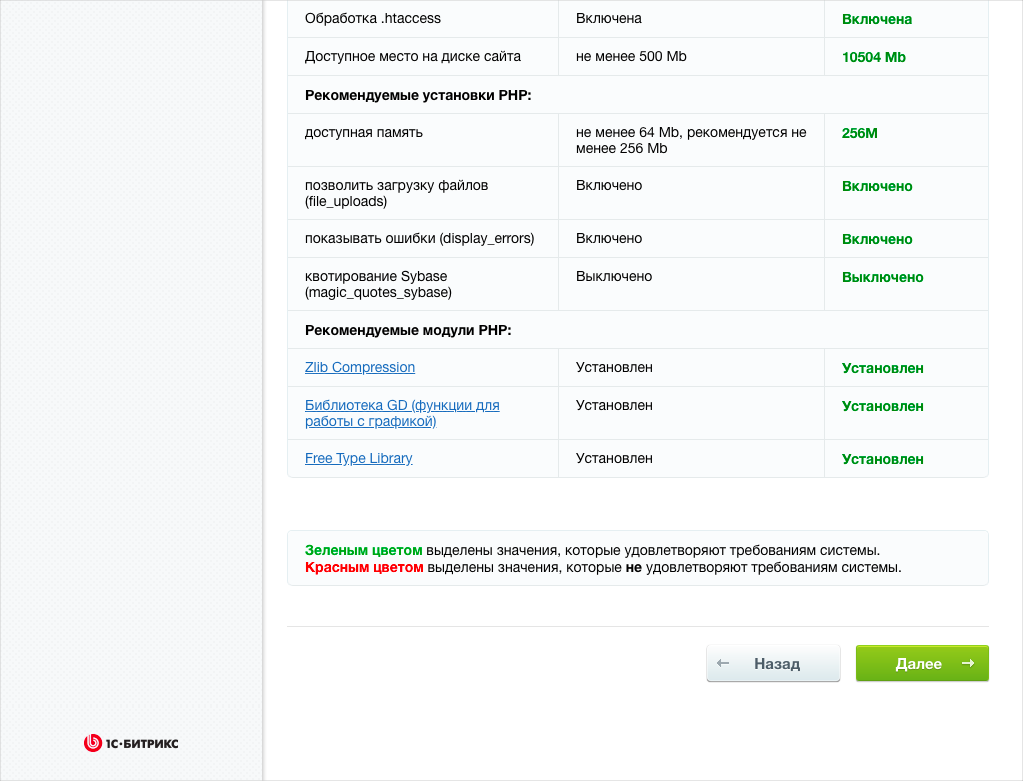
-
Configure the database:
- In the Server field, enter the fully qualified domain name (FQDN) of the DB you created. To find out this name:
- In the management console
- In the list of services, select Managed Service for MySQL.
- In the window that opens, select the
BitrixMySQLcluster you created earlier. - Select the Hosts tab in the left-hand menu.
- In the Host FQDN field, hover over the host name (format:
rc1c-cfazv1db********) and copy the database FQDN by clicking therc1c-cfazv1db********.mdb.yandexcloud.netformat.
- In the management console
- In the Username and Password fields, enter the data that you specified when creating the DB in Create a MySQL® DB cluster.
- In the Database name field, specify the name of the created DB (
db1). - Click Next.
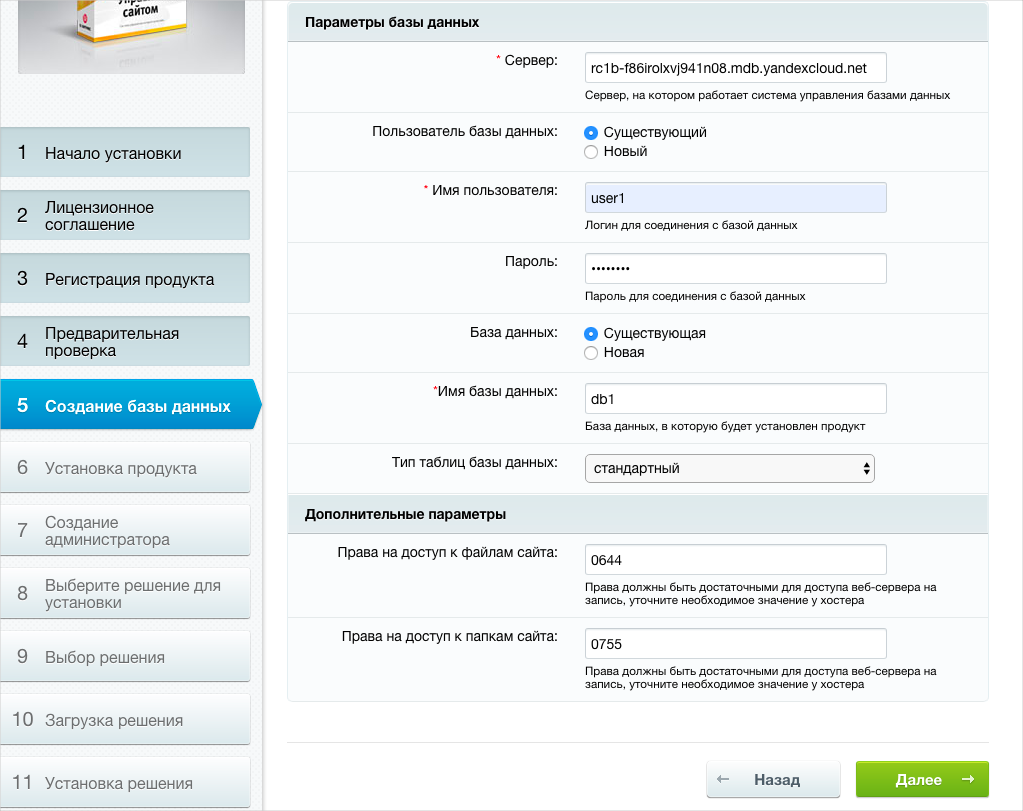
- In the Server field, enter the fully qualified domain name (FQDN) of the DB you created. To find out this name:
-
Wait for the system installation and DB initialization to complete.
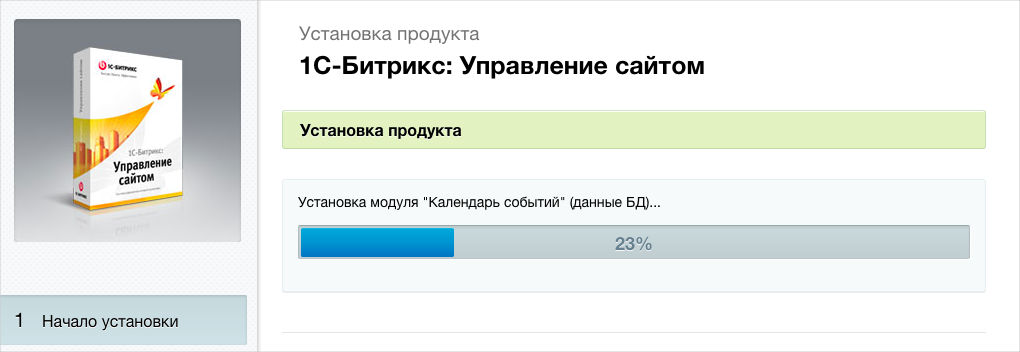
-
Create an administrator (a user to manage the system). Fill in the fields with your personal data and click Next.
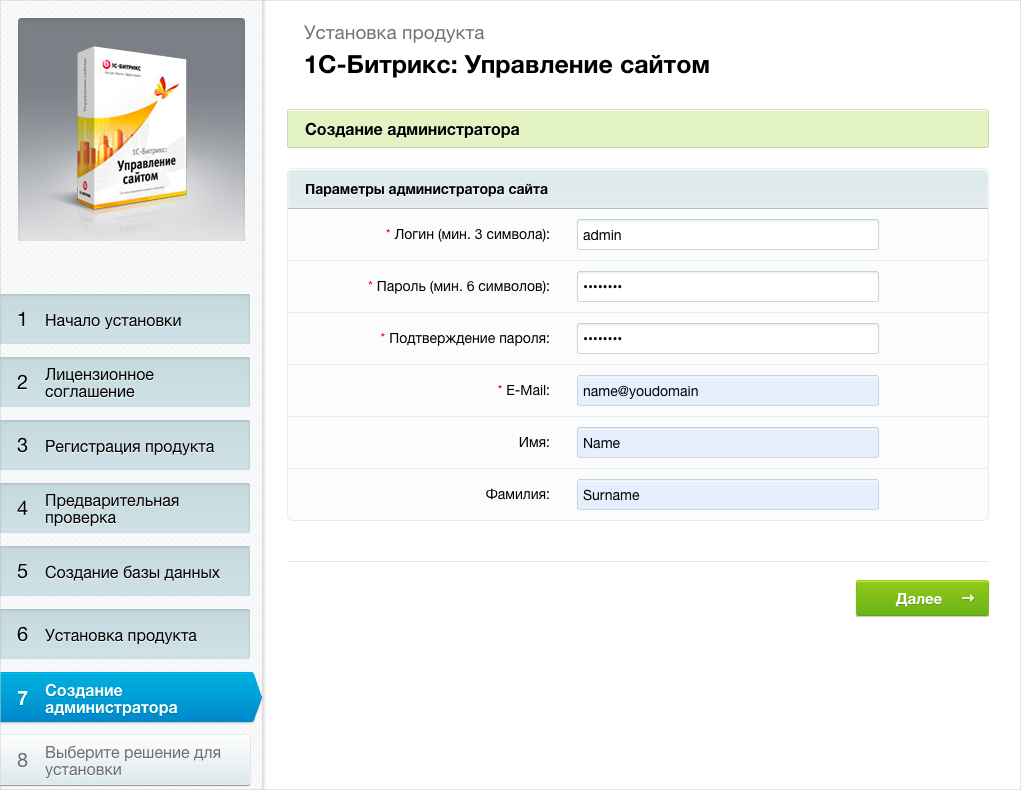
-
Select the Online store template and click Next.
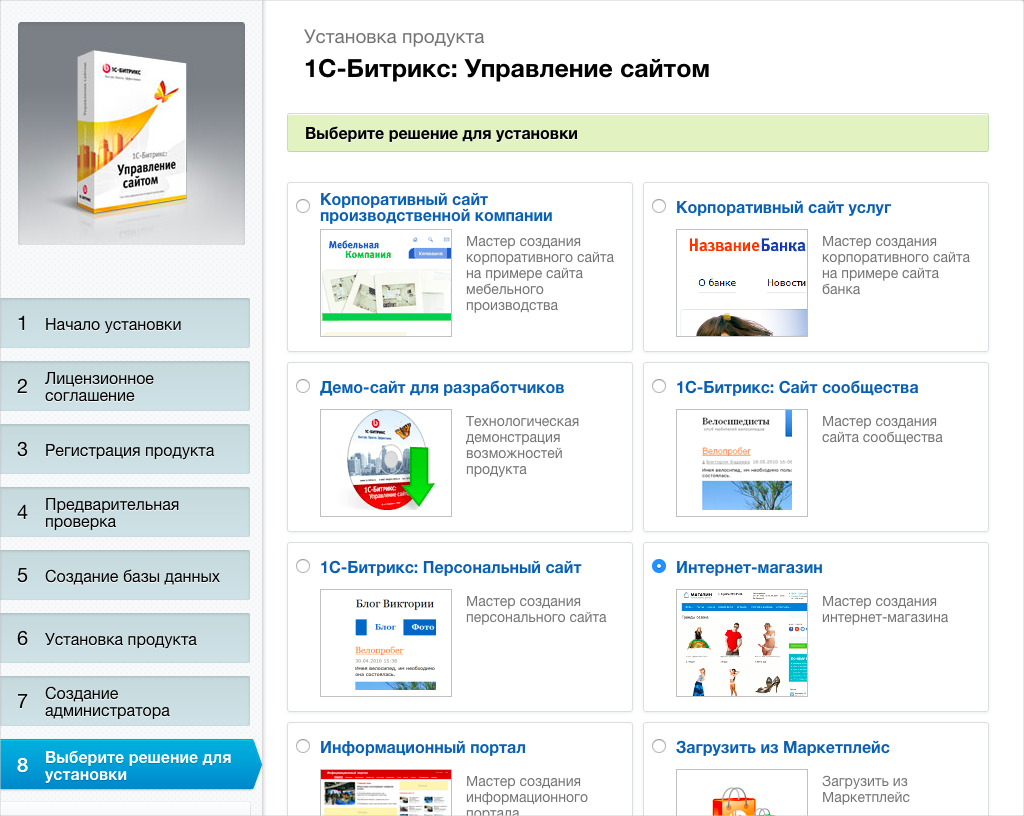
-
Confirm the selection of the only template and click Next.
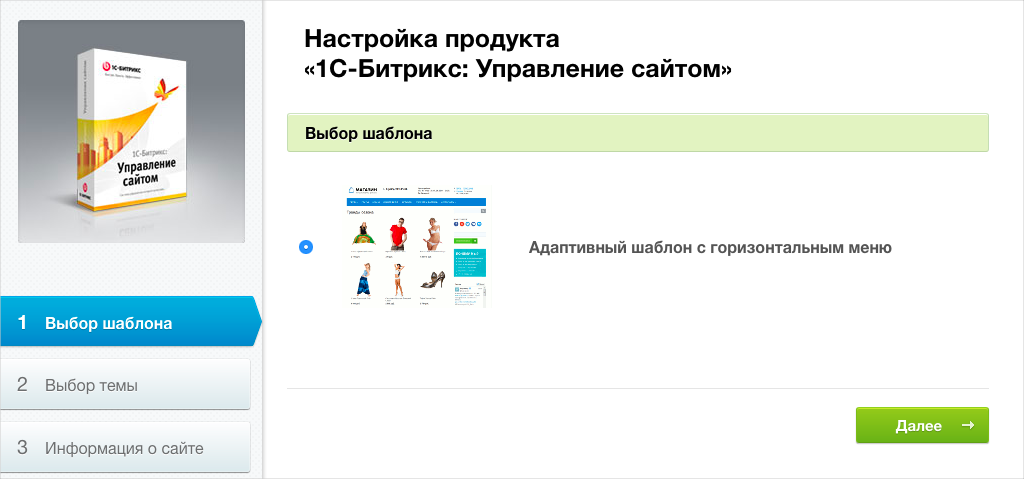
-
Select a color for the previously selected template and click Next.
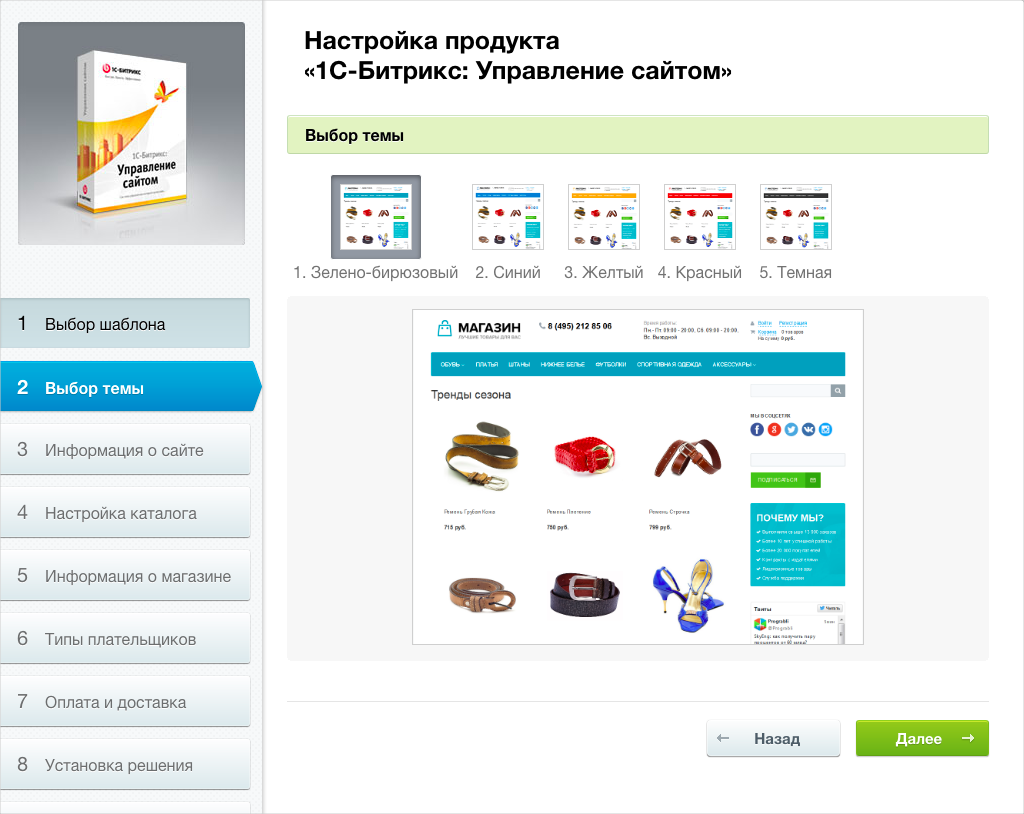
-
Fill in the fields according to your requirements for the online store and click Next.
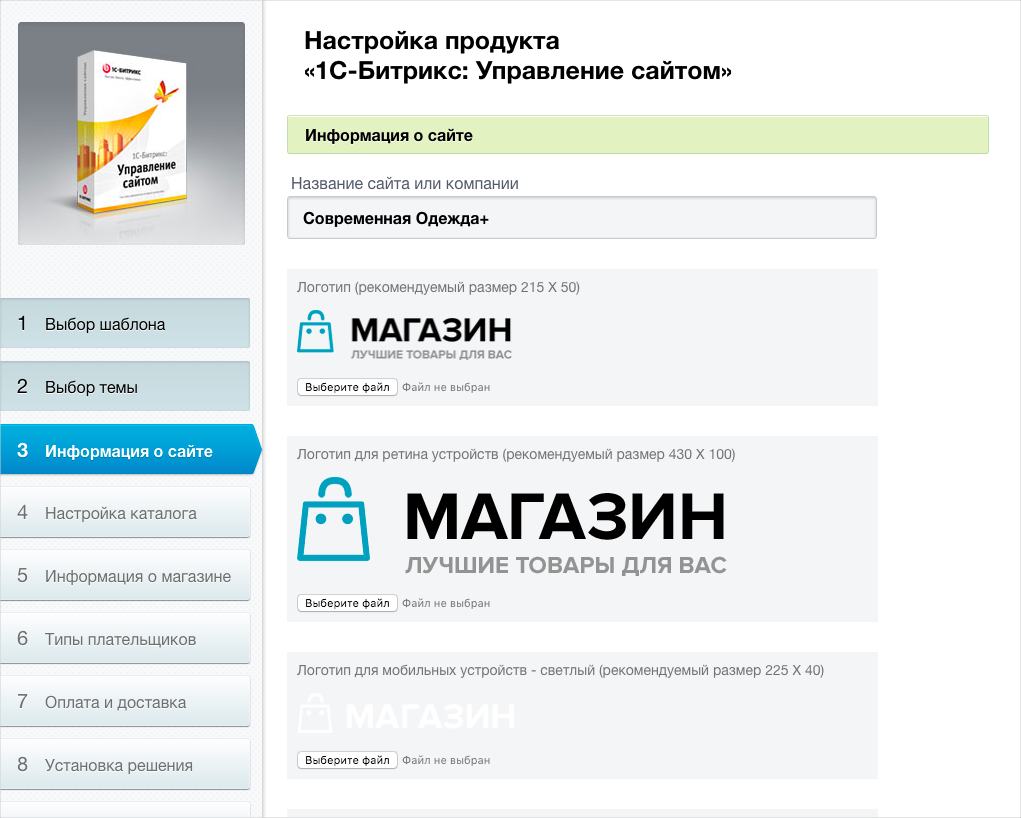
-
If necessary, enable the inventory management function and specify when to reserve items at the warehouse. Click Next.
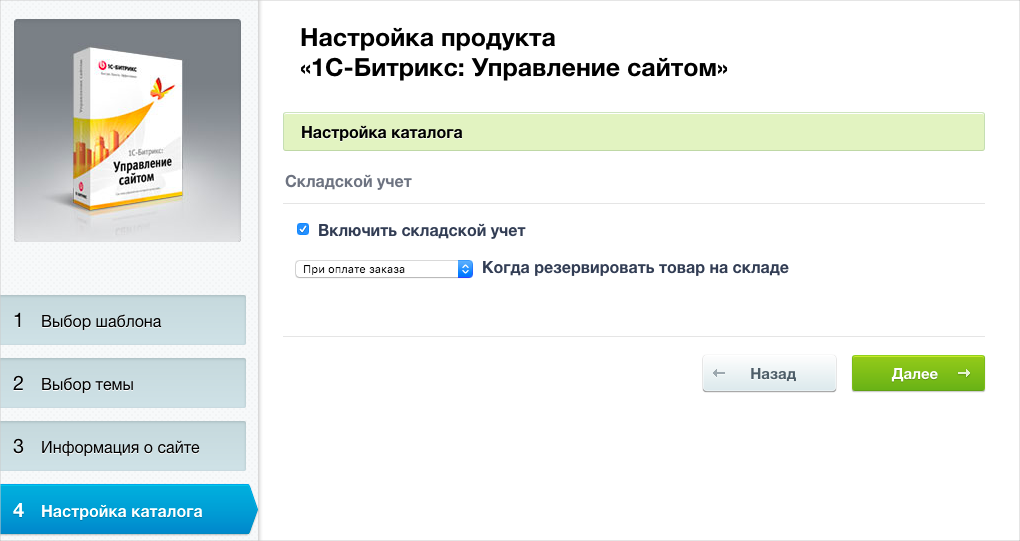
-
Enter your company information and click Next.
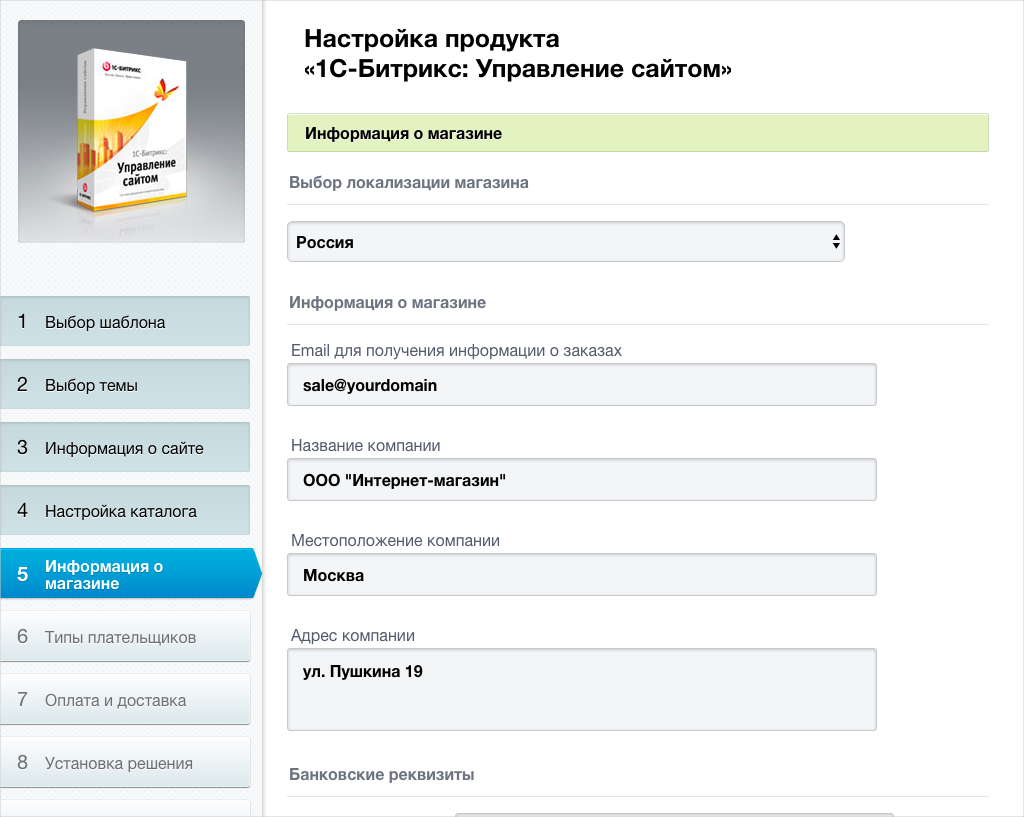
-
Select the types of payers your online store will work with and click Next.
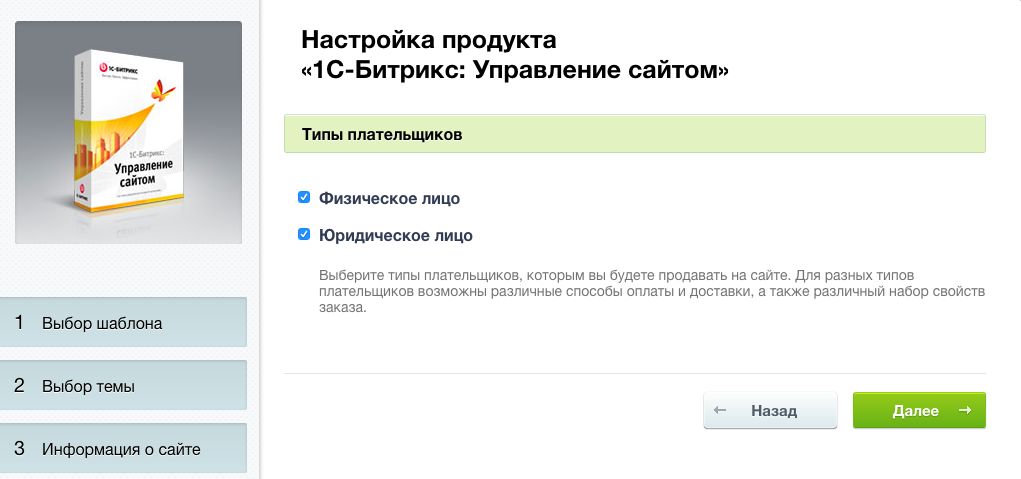
-
Select the payment and delivery methods your online store supports and click Next.
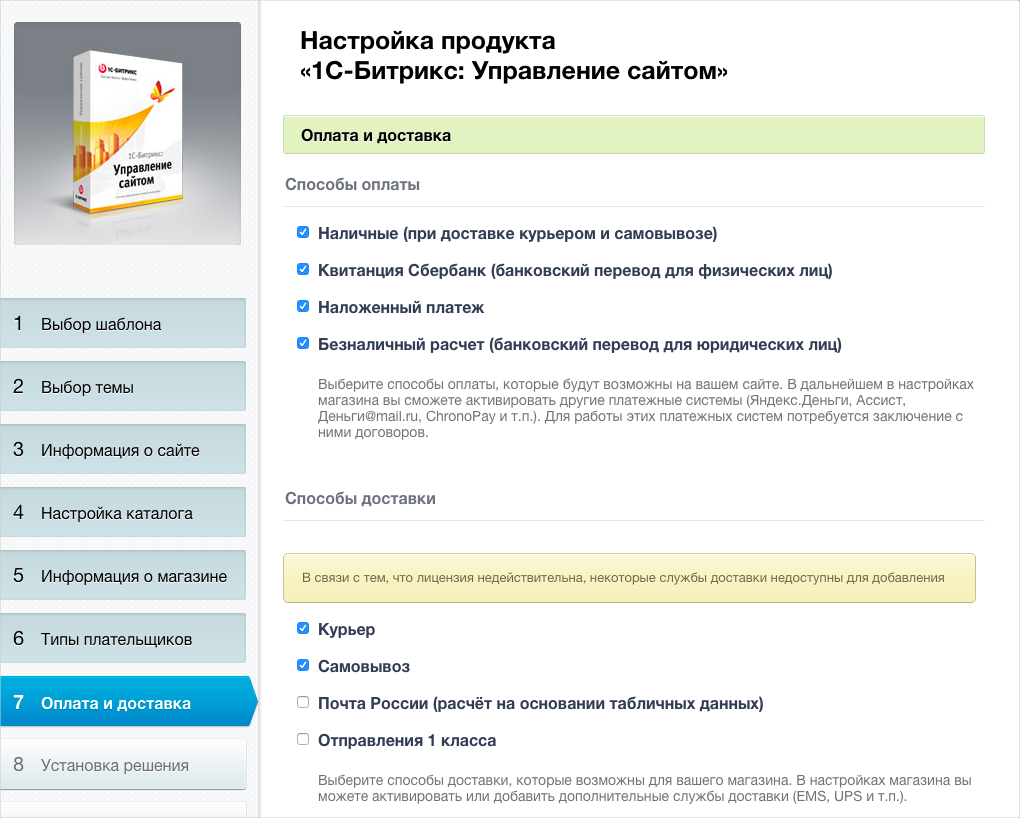
-
Wait for the system installation to complete.
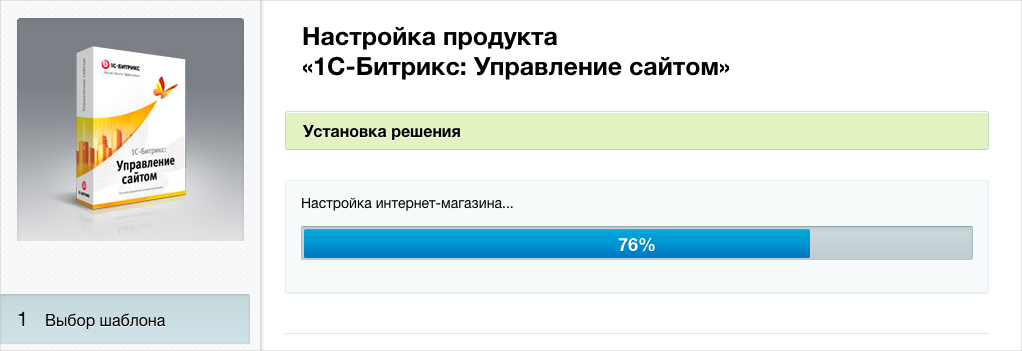
-
Once the installation is complete, click Go to website.
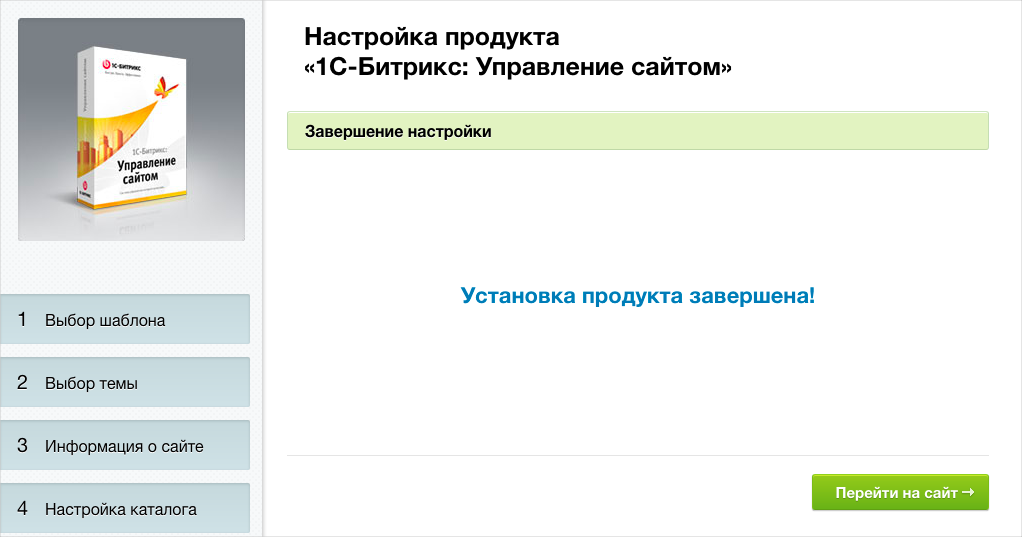
-
The online store interface will open in edit mode.
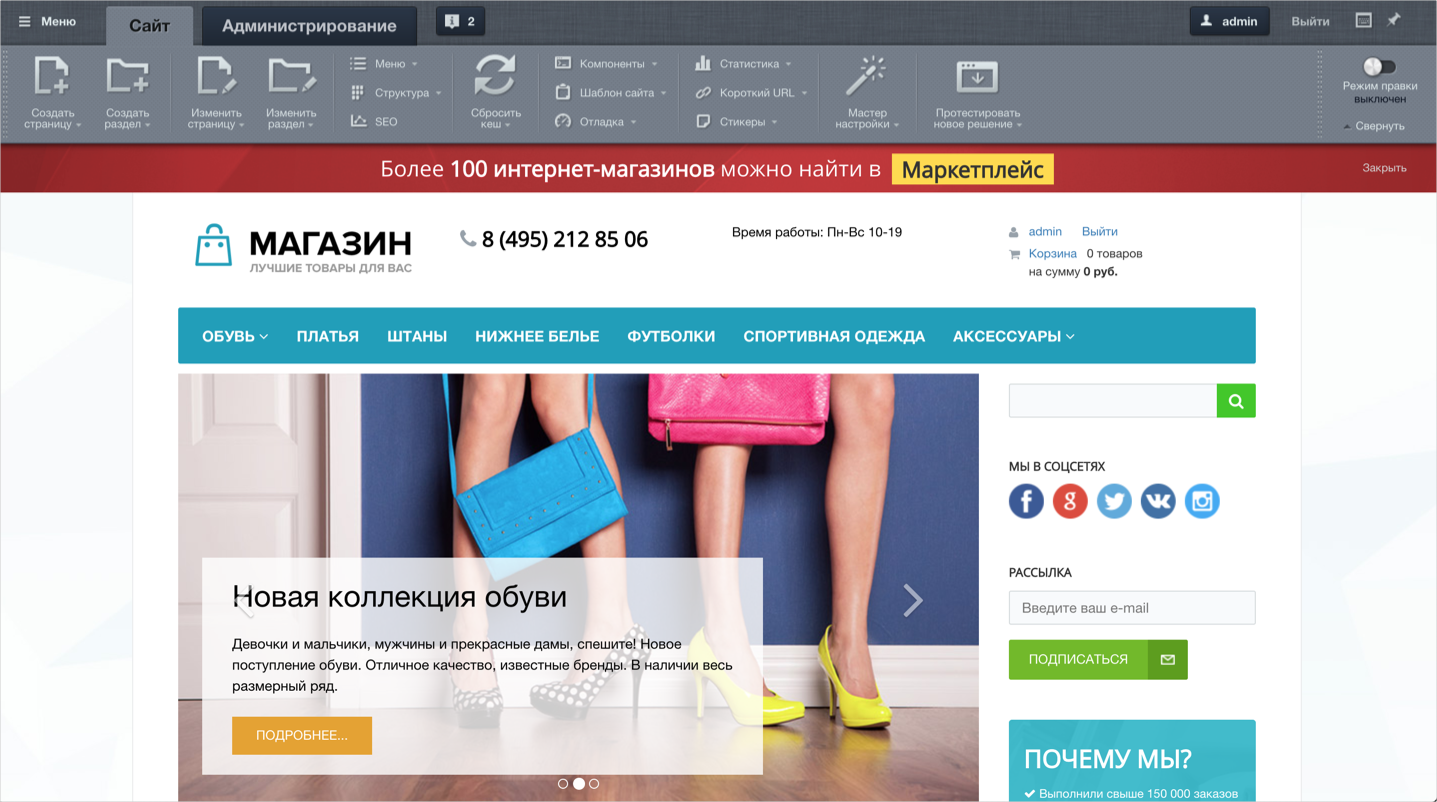
-
To view the website home page as a user, exit your website administration mode. To do this, click Exit in the top-right corner of the page and go to
http://<VM_public_IP_address>/.
To return to edit mode, log in to the website using the administrator credentials you provided when configuring 1C-Bitrix.
Tip
To get system backups, create disk snapshots on your VM from time to time.
How to delete the resources you created
To stop paying for the resources you created:
-
Open the
bitrix-website.tfconfiguration file and delete from it the description of the infrastructure you created. -
Apply the changes:
-
In the terminal, go to the directory where you edited the configuration file.
-
Make sure the configuration file is correct using this command:
terraform validateIf the configuration is correct, you will get this message:
Success! The configuration is valid. -
Run this command:
terraform planYou will see a detailed list of resources. No changes will be made at this step. If the configuration contains any errors, Terraform will show them.
-
Apply the changes:
terraform apply -
Type
yesand press Enter to confirm the changes.
-